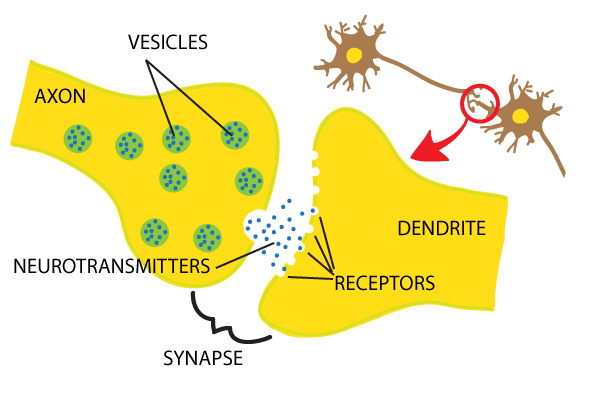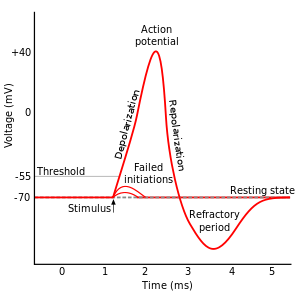An action potential is the only means by which a signal can be transmitted along a nerve cell. It is therefore down to these action potentials to communicate not only various stimuli but also their relative strengths.
It stands to reason that a stronger stimulus would just elicit a greater action potential. However, this is not the case! Although if the human body was indeed this logical and straightforward, physiologist’s lives would be far simpler.
Action potentials follow the all-or-nothing law. Thankfully, this law’s name neatly summarises its properties. To stimulate any action potential in a nerve cell, the stimulus must be greater than a specific threshold value (varies depending on the cell). If the stimulus is not larger than this threshold then no action potential will occur (as shown in figure 1). Conversely, if the stimulus exceeds this threshold potential an action potential will occur, and reach the same final value regardless of stimulus strength.
If all action potentials are the same size, how is information transmitted?
There are two main ways that stimulus strength can be communicated to the central nervous system and the brain.
- Frequency of action potentials
- Recruitment of nerve fibres
The brain interprets strength of stimulus mainly through the frequency of action potentials. A greater number of action potentials in quick succession from the same source of origin is due to greater stimulus strength. Recruitment is the activation of more nerve fibres. A greater stimulus will therefore activate more nerve fibres, which again will be detected by the brain. This is also true for communication from the brain to an effector organ (usually muscles). According to the type of stimulus and its strength the brain coordinates an appropriate response. The strength of this response is determined by action potential frequency and nerve fibre recruitment. If the brain decides a continual contraction of muscles is required then high action potential frequency will be sent to cause tetany (constant contraction of a muscle). Likewise, if more muscle power is necessitated then more muscle fibres will be recruited.
How is the type of stimulus communicated?
Receptors. Each stimulus is initially detected by a different receptor, and that receptor will begin the action potential that is deciphered by the brain. Stimuli arising from different receptors, whether it be heat, light, taste, pressure or sound, can be sensed and thus prompt a different response.
Have you ever noticed that you often see patterns of light when rubbing your eyes? This is because the brain is so accustomed to receiving light signals from the nerves within the eye that touch stimuli on the eyelid are misinterpreted as light. An example of the shortcoming of brain using receptor type to determine stimuli.
However, this is not the whole story. Only nerve cells and their forms of communication have been discussed. To properly understand this topic, the connections between these cells must be touched upon. These connections are known as synapses.

figure 2. A synapse
Synapses bridge the gap between two (or sometimes more) nerve cells using chemicals known as neurotransmitters. They play a critical role in communication both within the peripheral and central nervous systems. With some nerves having many synapses with multiple nerve cells, these connections are important in excitation and inhibition. Depending on the neurotransmitter used at a synapse it can cause either excitation or inhibition (a follow up article on synapses will be posted to explain this fully). Synapses are required in nervous system communication to block out or amplify various stimuli through this excitation or inhibition, while the use of different neurotransmitters can evoke a varying number of responses in the next nerve cell.
Background reading:
How do nerves conduct electrical impulses?
How do nerves carry electrical impulses so fast?
References:
http://www.tiem.utk.edu/~gross/bioed/webmodules/synapse.html
https://en.wikipedia.org/wiki/Action_potential
http://medical-dictionary.thefreedictionary.com/tetanic+contraction
https://en.wikipedia.org/wiki/Stimulus
https://www.ncbi.nlm.nih.gov/pubmed/21254534

I enjoyed the example of when you rub your eyes (the effect) and Thank you....I never understood what synapse was. I didn't "get it" that it was how different nerves interacted.
Thank you, I am glad you enjoyed reading it!
Congratulations @ovij! You have completed some achievement on Steemit and have been rewarded with new badge(s) :
Click on any badge to view your own Board of Honor on SteemitBoard.
For more information about SteemitBoard, click here
If you no longer want to receive notifications, reply to this comment with the word
STOPI amazing to think of how much nerves we have in a body an how the message to move an arm can happen in barely a second.
I know, it is crazy to think about
Peace, Abundance, and Liberty Network (PALnet) Discord Channel. It's a completely public and open space to all members of the Steemit community who voluntarily choose to be there.Congratulations! This post has been upvoted from the communal account, @minnowsupport, by ${username} from the Minnow Support Project. It's a witness project run by aggroed, ausbitbank, teamsteem, theprophet0, someguy123, neoxian, followbtcnews/crimsonclad, and netuoso. The goal is to help Steemit grow by supporting Minnows and creating a social network. Please find us in the
Congratulations @ovij! You have completed some achievement on Steemit and have been rewarded with new badge(s) :
Click on any badge to view your own Board of Honor on SteemitBoard.
For more information about SteemitBoard, click here
If you no longer want to receive notifications, reply to this comment with the word
STOPVery informative. I like articles that explain how the body works.
Thank you, many of my other articles explain the workings of the body.
Do any of your posts go into the explanation of how organic molecules bond. I'm studying organic chemistry and I can't understand how resonance works.
Thanks for posting this. Having experienced re-mission from the Miller/Fisher variant of Gullian-Barre (sp?), this clears many things for this simple mind.
No problem, I am glad that you found it interesting and useful!